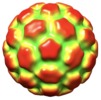+ Open data
Open data
- Basic information
Basic information
| Entry | Database: EMDB / ID: EMD-9733 | |||||||||
|---|---|---|---|---|---|---|---|---|---|---|
| Title | A T=4 icosahedral structure of HIV-1 capsid | |||||||||
 Map data Map data | ||||||||||
 Sample Sample |
| |||||||||
| Biological species |   Human immunodeficiency virus 1 Human immunodeficiency virus 1 | |||||||||
| Method | single particle reconstruction / cryo EM / Resolution: 25.0 Å | |||||||||
 Authors Authors | He MZ / Zhang ZQ / Jiang J / Zheng QB / Li SW / Gu Y | |||||||||
 Citation Citation |  Journal: Viruses / Year: 2018 Journal: Viruses / Year: 2018Title: T = 4 Icosahedral HIV-1 Capsid As an Immunogenic Vector for HIV-1 V3 Loop Epitope Display. Authors: Zhiqing Zhang / Maozhou He / Shimeng Bai / Feng Zhang / Jie Jiang / Qingbing Zheng / Shuangquan Gao / Xiaodong Yan / Shaowei Li / Ying Gu / Ningshao Xia /   Abstract: The HIV-1 mature capsid (CA) assumes an amorphous, fullerene conical configuration due to its high flexibility. How native CA self-assembles is still unclear despite having well-defined structures of ...The HIV-1 mature capsid (CA) assumes an amorphous, fullerene conical configuration due to its high flexibility. How native CA self-assembles is still unclear despite having well-defined structures of its pentamer and hexamer building blocks. Here we explored the self-assembly of an engineered capsid protein built through artificial disulfide bonding (CA N21C/A22C) and determined the structure of one fraction of the globular particles. CA N21C/A22C was found to self-assemble into particles in relatively high ionic solutions. These particles contained disulfide-bonding hexamers as determined via non-reducing SDS-PAGE, and exhibited two major components of 57.3 S and 80.5 S in the sedimentation velocity assay. Particles had a globular morphology, approximately 40 nm in diameter, in negative-staining TEM. Through cryo-EM 3-D reconstruction, we determined a novel T = 4 icosahedral structure of CA, comprising 12 pentamers and 30 hexamers at 25 Å resolution. We engineered the HIV-1 V3 loop to the CA particles, and found the resultant particles resembled the morphology of their parental particles in TEM, had a positive reaction with V3-specific neutralizing antibodies, and conferred neutralization immunogenicity in mice. Our results shed light on HIV CA assembly and provide a particulate CA for epitope display. | |||||||||
| History |
|
- Structure visualization
Structure visualization
| Movie |
 Movie viewer Movie viewer |
|---|---|
| Structure viewer | EM map:  SurfView SurfView Molmil Molmil Jmol/JSmol Jmol/JSmol |
| Supplemental images |
- Downloads & links
Downloads & links
-EMDB archive
| Map data |  emd_9733.map.gz emd_9733.map.gz | 298.5 MB |  EMDB map data format EMDB map data format | |
|---|---|---|---|---|
| Header (meta data) |  emd-9733-v30.xml emd-9733-v30.xml emd-9733.xml emd-9733.xml | 7.4 KB 7.4 KB | Display Display |  EMDB header EMDB header |
| Images |  emd_9733.png emd_9733.png | 153.9 KB | ||
| Archive directory |  http://ftp.pdbj.org/pub/emdb/structures/EMD-9733 http://ftp.pdbj.org/pub/emdb/structures/EMD-9733 ftp://ftp.pdbj.org/pub/emdb/structures/EMD-9733 ftp://ftp.pdbj.org/pub/emdb/structures/EMD-9733 | HTTPS FTP |
-Validation report
| Summary document |  emd_9733_validation.pdf.gz emd_9733_validation.pdf.gz | 78.5 KB | Display |  EMDB validaton report EMDB validaton report |
|---|---|---|---|---|
| Full document |  emd_9733_full_validation.pdf.gz emd_9733_full_validation.pdf.gz | 77.7 KB | Display | |
| Data in XML |  emd_9733_validation.xml.gz emd_9733_validation.xml.gz | 494 B | Display | |
| Arichive directory |  https://ftp.pdbj.org/pub/emdb/validation_reports/EMD-9733 https://ftp.pdbj.org/pub/emdb/validation_reports/EMD-9733 ftp://ftp.pdbj.org/pub/emdb/validation_reports/EMD-9733 ftp://ftp.pdbj.org/pub/emdb/validation_reports/EMD-9733 | HTTPS FTP |
-Related structure data
| Similar structure data |
|---|
- Links
Links
| EMDB pages |  EMDB (EBI/PDBe) / EMDB (EBI/PDBe) /  EMDataResource EMDataResource |
|---|---|
| Related items in Molecule of the Month |
- Map
Map
| File |  Download / File: emd_9733.map.gz / Format: CCP4 / Size: 347.6 MB / Type: IMAGE STORED AS FLOATING POINT NUMBER (4 BYTES) Download / File: emd_9733.map.gz / Format: CCP4 / Size: 347.6 MB / Type: IMAGE STORED AS FLOATING POINT NUMBER (4 BYTES) | ||||||||||||||||||||||||||||||||||||||||||||||||||||||||||||
|---|---|---|---|---|---|---|---|---|---|---|---|---|---|---|---|---|---|---|---|---|---|---|---|---|---|---|---|---|---|---|---|---|---|---|---|---|---|---|---|---|---|---|---|---|---|---|---|---|---|---|---|---|---|---|---|---|---|---|---|---|---|
| Projections & slices | Image control
Images are generated by Spider. | ||||||||||||||||||||||||||||||||||||||||||||||||||||||||||||
| Voxel size | X=Y=Z: 1.128 Å | ||||||||||||||||||||||||||||||||||||||||||||||||||||||||||||
| Density |
| ||||||||||||||||||||||||||||||||||||||||||||||||||||||||||||
| Symmetry | Space group: 1 | ||||||||||||||||||||||||||||||||||||||||||||||||||||||||||||
| Details | EMDB XML:
CCP4 map header:
| ||||||||||||||||||||||||||||||||||||||||||||||||||||||||||||
-Supplemental data
- Sample components
Sample components
-Entire : Human immunodeficiency virus 1
| Entire | Name:   Human immunodeficiency virus 1 Human immunodeficiency virus 1 |
|---|---|
| Components |
|
-Supramolecule #1: Human immunodeficiency virus 1
| Supramolecule | Name: Human immunodeficiency virus 1 / type: virus / ID: 1 / Parent: 0 / NCBI-ID: 11676 / Sci species name: Human immunodeficiency virus 1 / Virus type: VIRUS-LIKE PARTICLE / Virus isolate: OTHER / Virus enveloped: No / Virus empty: Yes |
|---|---|
| Host system | Organism:  |
-Experimental details
-Structure determination
| Method | cryo EM |
|---|---|
 Processing Processing | single particle reconstruction |
| Aggregation state | particle |
- Sample preparation
Sample preparation
| Buffer | pH: 8 |
|---|---|
| Vitrification | Cryogen name: ETHANE |
- Electron microscopy
Electron microscopy
| Microscope | FEI TECNAI F30 |
|---|---|
| Image recording | Film or detector model: FEI FALCON II (4k x 4k) / Average electron dose: 25.0 e/Å2 |
| Electron beam | Acceleration voltage: 300 kV / Electron source:  FIELD EMISSION GUN FIELD EMISSION GUN |
| Electron optics | Illumination mode: SPOT SCAN / Imaging mode: BRIGHT FIELD |
| Experimental equipment |  Model: Tecnai F30 / Image courtesy: FEI Company |
- Image processing
Image processing
| Final reconstruction | Resolution.type: BY AUTHOR / Resolution: 25.0 Å / Resolution method: FSC 0.143 CUT-OFF / Number images used: 722 |
|---|---|
| Initial angle assignment | Type: COMMON LINE |
| Final angle assignment | Type: COMMON LINE |
 Movie
Movie Controller
Controller











 Z (Sec.)
Z (Sec.) Y (Row.)
Y (Row.) X (Col.)
X (Col.)





















